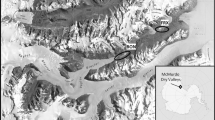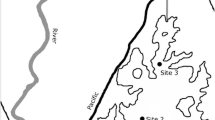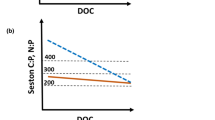Abstract
We examined the effects of different forms of nitrogen and mixed versus static conditions on the structure and function of natural Neuse River estuary phytoplankton communities incubated in 66-liter microcosms in March, May, August, and November 1999. Significant differences were found between effects of mixed versus static treatments in three of four experiments, but no differences were observed between effects of different forms of nitrogen. Mixed incubations resulted in higher contributions of diatoms to total community biomass (measured as chlorophylla) than in static tanks in May. Significantly higher rates of carbon fixation were also observed, likely due to increased suspension of diatoms in surface (illuminated) layers of the tanks. In August, we found significantly higher abundances of cyanobacteria, total community biomass, and rates of carbon fixation in static tanks than in tanks that were mixed. In November, static incubations showed significantly higher abundances of cryptophytes resulting in higher total community biomass and rates of carbon fixation in static tanks than in mixed tanks. Nitrogen additions significantly increased total community biomass relative to controls in May and August, indicating that the communities were nitrogen-limited at these times. We conclude that while nitrogen additions may result in increases in phytoplankton biomass when nitrogen is limiting, phytoplankton community structure in the Neuse River Estuary may be determined more by the hydrodynamics of the system (mixing versus stratification) than by the form of nitrogen available for growth.
Similar content being viewed by others
Literature Cited
Boyer, J. N., R. R. Christian, andD. W. Stanley. 1993. Patterns of phytoplankton primary productivity in the Neuse River estuary, North Carolina, USA.Marine Ecology Progress Series 97:287–297.
Burford, M. A., andD. C. Pearson. 1998. Effect of different nitrogen sources on phytoplankton composition in aquaculture ponds.Aquatic Microbial Ecology 15:277–284.
Carpenter, E. J., andR. R. L. Guillard. 1971. Intraspecific differences in nitrate half-saturation constants for three species of marine phytoplankton.Ecology 52:183–185.
Christian, R. R., W. L. Bryant, and D. W. Stanley. 1986. The relationship between river flow andMicrocystis aeruginosa blooms in the Neuse River, North Carolina. Report of the Water Resources Research Institute of the University of North Carolina, No. 223, Raleigh, North Carolina.
Cloern, J. E.. 1987. Turbidity as a control on phytoplankton biomass and productivity in estuaries.Continental Shelf Research 7:1367–1381.
Cloern, J. E.. 1996. Phytoplankton bloom dynamics in coastal ecosystems: A review with some general lessons from sustained investigation of San Francisco Bay, California.Reviews of Geophysics 34:127–168.
Cole, B. E. andJ. E. Cloern. 1984. Significance of biomass and light availability to phytoplankton productivity in San Francisco Bay.Marine Ecology Progress Series 17:15–24.
Collos, Y.. 1989. A linear model of external interactions during uptake of different forms of inorganic nitrogen by microalgae.Journal of Plankton Research 11:521–533.
Copeland, B. J., H. W. Paerl, J. D. Bates, D. W. Stanley, E. Kuenzler, andA. Klimek. 1991. Water quality, p. 1–61.In J. Steal (ed.), Status and Trends Report of the Albemarle-Pamlico Estuary. Albemarle-Pamlico Estuarine Study Report 90-01. North Carolina Department of the Environment and Natural Resources, Raleigh, North Carolina.
Cullen, J. J. andM. R. Lewis. 1988. The kinetics of algal photoadaptation in the context of vertical mixing.Journal of Plankton Research 10:1039–1063.
Dortch, Q. 1990. The interaction between ammonium and nitrate uptake in phytoplankton.Marine Ecology Progress Series 61:183–201.
Eloff, J. N., Y. Steinitz, andM. Shilo. 1976. Photooxidation of cyanobacteria in natural conditions.Applied and Environmental Microbiology 31:119–126.
Eppley, R. W., J. N. Rogers, andJ. J. McCarthy. 1969. Half saturation constants for uptake of nitrate and ammonia by marine phytoplankton.Limnology and Oceanography 14:912–920.
Fensin, E. 1998. Seasonal population dynamics of the phytoplankton community, and ofPfiesteria piscicida/Pfiesteria-like dinoflagellates in the mesohaline Neuse Estuary, North Carolina. M.S. Thesis, North Carolina State University, Raleigh, North Carolina.
Harding, Jr.,L. W., B. W. Meeson, andT. R. Fisher, Jr. 1986. Phytoplankton production in two east coast estuaries: Photosynthesis-light function and patterns of carbon assimilation in Chesapeake and Delaware Bays.Estuarine and Coastal Shelf Science 23:773–806.
Hobbie, J. E., andN. W. Smith. 1975. Nutrients in the Neuse River estuary, NC. Report No. UNC-SG-75-21, University of North Carolina Sea Grant Program, North Carolina State University, Raleigh, North Carolina.
Huisman, J., R. R. Jonker, C. Zonneveld, andF. J. Weissing. 1999a. Competition for light between phytoplankton species: Experimental tests of mechnistic theory.Ecology 80:211–222.
Huisman, J., P. van Oostveen, andF. J. Weissing. 1999b. Species dynamics in phytoplankton booms: Incomplete mixing and competition for light.American Naturalist 154:46–68.
Jeffrey, S., R. Mantoura, andS. Wright (eds.) 1997. Phytoplankton Pigments in Oceanography: Guidelines to Modern Methods. United Nations Educational, Scientific and Cultural Organization Publishing, Paris.
Kirk, J. T. O. 1994. Light and Photosynthesis in Aquatic Ecosystems, 2nd ed. Cambridge University Press, Cambridge.
Mackey, M. D., D. J. Mackey, H. W. Higgins, andS. W. Wright. 1996. CHEMTAX—A program for estimating class abundances from chemical markers: Application to HPLC measurements of phytoplankton.Marine Ecology Progress Series 144:265–283.
Mallin, M. A., andH. W. Paerl. 1994. Planktonic trophic transfer in an estuary: Seasonal, diel, and community structure effects.Ecology 75:2168–2184.
Mantoura, R., andC. Llewellyn. 1983. The rapid determination of algal chlorophyll and carotenoid pigments and their breakdown products in natural waters by reverse-phase high-performance liquid chromatography.Analytica Chimica Acta 151:297–314.
Margalef, R.. 1978. Life-forms of phytoplankton as survival alternatives in an unstable environment.Oceanologica Acta 1:493–509.
Millie, D., H. W. Paerl, andJ. Hurley. 1993. Microalgal pigment assessments using high-performance liquid chromatography: A synopsis of organismal and ecological applications.Canadian Journal of Fisheries and Aquatic Sciences 50:2513–2527.
Neilson, A. H. andT. Larsson. 1980. The utilization of organic nitrogen for growth of algae: Physiological aspects.Physiologia Plantarum 48:542–553.
Neter, J., W. Wasserman, andM. Kutner. 1985. Applied Linear Statistical Models. R. D. Irwin, Inc., Homewood, Illinois.
Nixon, S. W.. 1996. North Carolina state senate committee on water quality and fish kills, 1996 Summary Report. Water Resources Research Institute of the University of North Carolina. Raleigh, North Carolina.
Oliver, R. L.. 1994. Floating and sinking in gas-vacuolate cyanobacteria.Journal of Phycology 30:161–173.
Oliver, R. L., andA. E. Walsby. 1984. Direct evidence for the role of light-mediated gas vesicle collapse in the buoyancy regulation ofAnabaena flos-aquae (cyanobacteria).Limnology and Oceanography 29:879–886.
Olli, K.. 1999. Diel vertical migration of phytoplankton and heterotrophic flagellates in the Gulf of Riga.Journal of Marine Systems 23:145–163.
Paerl, H. W. 1983. Factors regulating nuisance blue-green algal bloom potentials in the lower Neuse River. Report No. 177 of University of North Carolina Water Resources Research Institute, Raleigh, North Carolina.
Paerl, H. W., M. A. Mallin, C. Donahue, M. Go, and B. L. Peierls. 1995. Nitrogen loading sources and eutrophication of the Neuse River estuary, NC: Direct and indirect roles of atmospheric deposition. Report of the University of North Carolina Water Resources Research Institute, No. 291, Raleigh, North Carolina.
Paerl, H. W., M. A. Mallin, J. Rudek, andP. Bates. 1990. The potential for eutrophication and nuisance algal blooms in the lower Neuse River, NC. Albemarle-Pamlico Estuarine Study Report 90-15. North Carolina Department of Natural Resources and Community Development, Raleigh, North Carolina.
Paerl, H. W., J. L. Pinckney, J. M. Fear, andB. L. Peierls. 1998. Ecosystem responses to internal and watershed organic matter loading: Consequences for hypoxia in the eutrophying Neuse River Estuary, North Carolina, USA.Marine Ecology Progress Series 166:17–25.
Parsons, T. R., Y. Maita, andC. M. Lalli. 1984. A Manual of Chemical and Biological Methods for Seawater Analysis. Pergamon Press, New York.
Pennock, J. R.. 1985. Chlorophyll distributions in the Delaware Estuary: Regulation by light limitation.Estuarine and Coastal Shelf Science 21:711–725.
Pennock, J. R. andJ. H. Sharp. 1994. Temporal alteration between light- and nutrient-limitation of phytoplankton production in a coastal plain estuary.Marine Ecology Progress Series 111: 275–288.
Petersen, J. E., C.-C. Chen, andW. M. Kemp. 1997. Scaling aquatic primary productivity: Experiments under nutrientand light-limited conditions.Ecology 78:2326–2338.
Petersen, J. E., L. P. Sanford, andW. M. Kemp. 1998. Coastal plankton responses to turbulent mixing in experimental ecosystems.Marine Ecology Progress Series 171:23–41.
Pinckney, J. L., D. F. Millie, K. E. Howe, H. W. Paerl, andJ. P. Hurley. 1996. Flow scintillation counting of14C-labeled microalgal photosynthetic pigments.Journal of Plankton Research 18:1867–1880.
Pinckney, J. L., D. F. Millie, B. T. Vinyard, andH. W. Pearl. 1997. Environmental controls of phytoplankton bloom dynamics in the Neuse River estuary, North Carolina, USA.Canadian Journal of Fisheries and Aquatic Sciences 54:2491–2501.
Pinckney, J. L., H. W. Paerl, andM. B. Harrington. 1999. Responses of the phytoplankton community growth rate to nutrient pulses in variable estuarine environments.Journal of Phycology 35:1455–1464.
Pinckney, J. L., H. W. Paerl, M. B. Harrington, andK. E. Howe. 1998. Annual cycles of phytoplankton community-structure and bloom dynamics in the Neuse River estuary, North Carolina.Marine Biology 131:371–381.
Roelke, D. L., L. A. Cifuentes, andP. M. Eldridge. 1997. Nutrient and phytoplankton dynamics in a sewage-impacted Gulf Coast estuary: A field test of the PEG-Model and equilibrium resource competition theory.Estuaries 20:725–742.
Rowan, K.. 1989. Photosynthetic Pigments of the Algae. Cambridge University Press, New York.
Rudek, J., H. W. Paerl, M. A. Mallin, andP. W. Bates. 1991. Seasonal and hydrological control of phytoplankton nutrient limitation in the lower Neuse River estuary, North Carolina.Marine Ecology Progress Series 75:133–142.
Sanford, L. P.. 1997. Turbulent mixing in experimental ecosystem studies.Marine Ecology Progress Series 161:265–293.
Scheiner, S. andJ. Gurevitch (eds.). 1993. Design and Analysis of Ecological Experiments. Chapman and Hall, New York.
Schlüter, L., F. Møhlenberg, H. Havskum, andS. Larsen. 2000. The use of phytoplankton pigments for identifying and quantifying phytoplankton pigments for identifying and quantifying phytoplankton groups in coastal areas: Testing the influence of light and nutrients on pigment/chlorophylla ratios.Marine Ecology Progress Series 192:49–63.
Stolte, W., T. McCollin, A. Noodeloos, andR. Riegman. 1994. Effect of nitrogen source on the size distribution within marine phytoplankton populations.Journal of Experimental Marine Biology and Ecology 184:83–97.
Syrett, P. J. 1981. Nitrogen metabolism of algae.In T. Platt (ed.), Physiological Bases of Phytoplankton Ecology.Canadian Bulletin of Fisheries and Aquatic Sciences 210:182–210.
Thompson, P. A., M. E. Levasseur, andP. J. Harrison. 1989. Light-limited growth on ammonium vs. nitrate: What is the advantage for marine phytoplankton?Limnology and Oceanography 34:1014–1024.
Turpin, D. H.. 1991. Effects of inorganic N availability on algal photosynthesis and carbon metabolism.Journal of Phycology 27:14–20.
Van Rijn, J., M. Shilo, andS. Diab. 1986. Phytoplankton succession in relation to nitrogen regime in shallow, brackishwater fish ponds.Archives of Hydrobiology 111:183–195.
Vincent, W. F.. 1992. The daily pattern of nitrogen uptake by phytoplankton in dynamic mixed layer environments.Hydrobiologia 238:37–52.
Wofsy, S. C.. 1983. A simple model to predict extinction coefficients and phytoplankton biomass in eutrophic waters.Limnology and Oceanography 28:1144–1155.
Wright, S., S. Jeffrey, R. Mantoura, C. Llewellyn, T. Bjørnland, D. Repeta, andN. Welschmeyer. 1991. An improved HPLC method for the analysis of chlorophylls and carotenoids from marine phytoplankton.Marine Ecology Progress Series 77:183–196.
Wright, S. W., D. P. Thomas, H. J. Marchant, H. W. Higgins, M. D. Mackey, andD. J. Mackey. 1996. Analysis of phytoplankton of the Australian sector of the Southern Ocean: Comparisons of microscopy and size frequency data with interpretations of pigment HPLC data using the ‘CHEMTAX’ matrix factorization program.Marine Ecology Progress Series 144:285–298.
Source of Unpublished Materials
Moisander, P. Personal Communication. Institute of Marine Sciences, University of North Carolina at Chapel Hill, Morehead City, North Carolina 28557.
Author information
Authors and Affiliations
Rights and permissions
About this article
Cite this article
Richardson, T.L., Pinckney, J.L. & Paerl, H.W. Responses of estuarine phytoplankton communities to nitrogen form and mixing using microcosm bioassays. Estuaries 24, 828–839 (2001). https://doi.org/10.2307/1353174
Received:
Accepted:
Issue Date:
DOI: https://doi.org/10.2307/1353174




